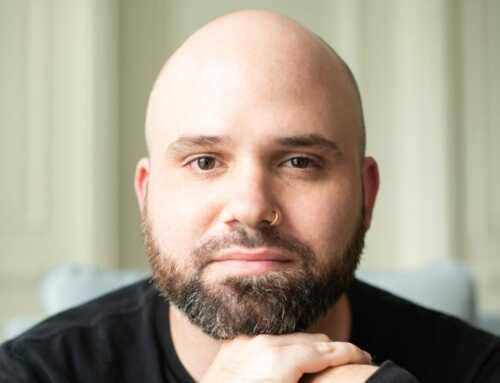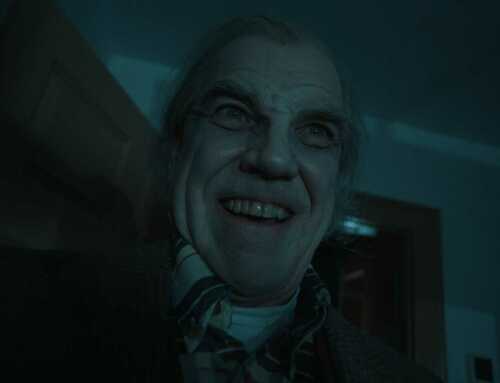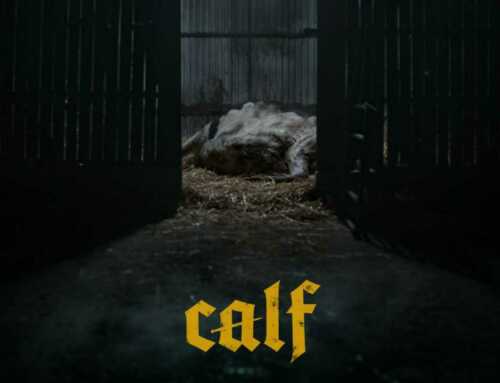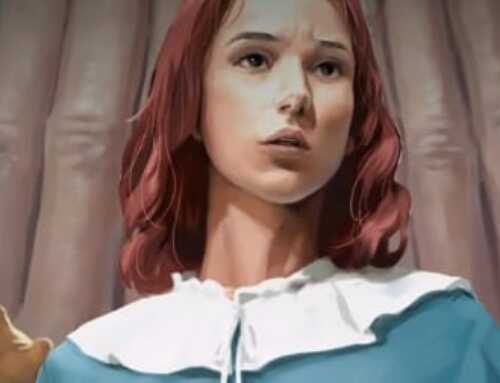Mountain Murder Tapes was conceived by co-writers and co-directors Jacob Seltzer and Benjy Steinberg, two hiking buddies who were inspired by Instagram video postings of a skiing trip Jacob had gone on in the winter of 2021. The friends incubated the idea of a contained thriller series set in a ski cabin that focused on minimal storytelling, with only one camera and the actors. The series, produced by Mary Dwyer and Erin Russoniello, dropped on TikTok earlier this year, and has seen great success since, marking a new, groundbreaking phase of indie filmmaking in the digital age.
We here at HorrorBuzz spoke with Jacob, Benjy, Mary, and Erin, the minds behind Mountain Murder Tapes, about their unique approach to the horror series, their collaboration styles, and their top horror inspirations.
What inspired you to become filmmakers?
Jacob Seltzer (JS): Growing up, going to the local public library to check-out books and DVDs was one of my favorite activities. One day, when I was in fifth grade, I wandered into a far corner of the library and through a “secret” door and stumbled upon the local public access television studio. It was a place with MiniDV video cameras, lights, tripods, editing consoles with Final Cut Pro (before it was ruined), but most of all, it had a community of filmmakers. They taught me the fundamentals of filmmaking, including a crash course in film history, and I was hooked. I would volunteer to film productions, in the process soaking in as much knowledge about the craft of filmmaking. Eventually I built up the confidence to try my hand at writing and directing my own projects. Every step of the way, I had just a little bit more encouragement to keep going – from an encouraging film teacher, an acceptance to a film festival, or a fellowship. After college, I moved out to LA with a dream and not much else. After PA-ing on a variety of sets, I eventually landed a job as an assistant to a talent manager at a big management company. One of the literary managers at the company took an interest in my writing and started representing me. I’ve been writing feature screenplays and directing my own projects – like Mountain Murder Tapes – slowly but surely building a career in filmmaking.
Benjy Steinberg (BS): I wasn’t allowed to watch TV growing up. So, instead, I read. A lot. My dad taught international criminal law at overseas universities. Sometimes the universities would relocate us with him for a summer or a semester. So we’d have these never-ending – to a kid, at least – transcontinental flights. I remember sneaking off from the flight gate into airport newsstands and spending my allowance money on these crime thriller mystery novels I had no business reading at that age. Dan Brown, Mary Higgins Clark… About serial killers. Assassination plots. Child abductions. I was nine. Anyways, I would read one or two of these books over the course of a ten-hour flight while my parents were out cold. This turned into an obsession with mysteries and thrillers. I moved on to Agatha Christie & Arthur Conan Doyle in middle school, then discovered Crime & Punishment in high school. It became my favorite novel. All this crystallized into me writing for TV & film after two events when I was 20. Spring of my junior year at Yale, I applied to Pulitzer-prize-winning novelist Michael Cunningham’s (“The Hours”) fiction-writing workshop. His central creative edict was to “conjure people out of thin air.” I found this phrasing of what fiction is to be so magical and inspiring. Then, that summer, I happened to watch my first TV show ever – the crime thriller HBO miniseries The Night Of. After one episode, I immediately knew I wanted to write TV. It was the perfect balance of psychological intrigue and a critical, frank approach to social issues. Afterwards, I couldn’t help myself. I started writing TV pilots and screenplays.
Mary Dwyer (MD): I’ve always been a voracious reader. Growing up, I shared all of my favorite books with my “cool Aunt”/unlikely best friend, who was about the same age that I am now and pursuing a career as a producer. During our slumber parties, she’d research who held the rights to my favorite books and we’d brainstorm how the stories would unfold on screen. Eventually our sleepovers and her hard work paid off, and she developed a Netflix show for a book that I shared with her when I was twelve-years-old, “13 Reasons Why.” From then on, she’d share scripts with me, which helped me learn how to write and give notes to writers. As I got older I started to make friends my own age who were aspiring filmmakers. Giving notes on their writing became a hobby of mine while I pursued my degree in engineering. Overtime, my friends let me know that this “hobby” was actually called producing, and clued me into the fact that I was a filmmaker myself.
Erin Russoniello (ER): My love for film, and specifically horror, comes from my mom. From an early age, she and I would spend Sunday mornings watching horror movies – everything from the weekly specials on Chiller Network to staples like Scream and Halloween. What started as a fun weekly activity quickly became an obsession, as I spent my childhood looking for the next horror film to keep me up at night. In college, I was thrilled to be surrounded by peers who shared the same love for film. Seeing my friends bring scripts to life in their film courses is what first opened me up to the reality that filmmaking was something I could be an active participant in. After graduating, Los Angeles introduced me to wonderful friends and collaborators, such as the Mountain Murder Tapes crew, who have a similar passion for film and have inspired me to take the plunge into filmmaking.
What was the inspiration behind the found footage format for Mountain Murder Tapes?
(JS & BS): We routinely hike together and discuss story ideas on these hikes. Throughout Winter 2021/2022, Jacob posted a bunch of videos of him skiing to Instagram and Benjy found one video of Jacob skiing through the woods really spooky and compelling. If someone disappeared in a remote place while filming themselves, the only thing left of them would be what they filmed.
When Jacob returned from his ski trip, we set off on a hike to Eaton Canyon Falls in the Angeles National Forest. As we returned to our cars after sunset in the remote, darkening woods, we discussed Jacob’s POV ski videos – and conceived of a found footage horror story akin to The Blair Witch Project – for both of us, a favorite horror movie. At Chengdu Taste restaurant after the hike, we began outlining a found footage horror film set on a remote ski mountain on our napkins.
With only a few weeks left of the ski season, we spent every day of the month of March writing together so that we could film the project that year. After writing drafts, we’d turn to Mary and Erin for feedback, notes, and development. They were both elevating the plot, characters, and horror elements. Once they felt the script was ready, they jumped in to produce.
At the time, Benjy was working on a major television show and Jacob had just wrapped a high budget short. We wanted to create a project that brought us back to the origin of filmmaking by focusing on only the story, one camera, and the actors. By stripping everything else away, we found that we were able to make something longer, more complex, and with a larger audience than we ever had as independent filmmakers before.
TikTok lent itself to an entirely new style of story-telling for us. Not only did TikTok help connect the project with a larger audience, but it also changed our approach to storytelling. During the writing process, we ensured that every shot was motivated by something, constantly asking “Why is the camera on?,” “Does this scene accurately reflect how this character would use her phone?” Distributing on TikTok is different from film & TV being that the person editing and uploading these videos also needed to be a character herself. Getting in the head of our distributor, who is also the stalker/killer in our story, added a fun element to not only the writing, but also the production, and distribution. We were also able to learn from the platform as we distributed the project. As we distributed, we learned more about what effective hooks were, how to gain followers, how to provoke people to click-through to our page, and were incorporating our learnings into each new episode.
What are the biggest challenges you faced when making this project?
(JS & BS): We wanted to make sure that we could utilize some high budget ski-infrastructure set pieces like the gondola, but we were constrained by our extremely low budget. So, we borrowed season passes from friends and snuck all the actors onto the gondola, our hearts beating fast that we’d get caught and have the passes confiscated. We didn’t want to push our luck, so we wanted to get the shot in one gondola ride. Fortunately our incredible actors Caroline Deery, Spencer Levin, Nova Chez, and Kendrick Kirk over delivered, providing our favorite moments of character and relationship development. And at the top of the gondola, Tahmus Rounds immediately transported the kids into their new world with his portrayal of the eccentric and volatile gondola attendant.
(MD): By distributing our film in short episodes everyday on TikTok, we were able to learn how to better shape the story as we shared it with world. After every release, we’d evaluate how the episodes performed and incorporate those learnings into the next day’s episodes. This led to a really thrilling all-hands-on-deck approach to distribution, with the whole team revisiting all of the footage for Jacob and Benjy to reshape the episodes on a daily basis. It was really cool to be able to learn from our audience in real time and make adjustments based on what resonated with them the most.
(ER): We were up against the elements, as much of our shoot took place in the wintery woods. We really leaned into each other to find creative solutions on the fly – staying flexible with the shooting schedule to chase peak weather conditions, ensuring actors were comfortable and safe, and covering each other when unexpected challenges came up. I’m really proud of how openly we communicated as a team to make sure we got what we needed.
How did you collaborate with your team to bring your vision to life?
(JS & BS): Improvisation was a huge part of the project and we cast incredibly talented actors who could take their characters to the next level. We wrote a fully formed script that would stand on its own without any improvisation, but we used improv to keep the scenes organic and spontaneous. Caroline, Nova, Spencer, Kendrick, and Tahmus are phenomenal improvisers – not only comically, but also dramatically. Their amazing off-the-cuff dialogue gave the footage the freshness needed to suspend disbelief that we’re really watching four college kids filming themselves on vacation with their phones.
(MD): We are a four-person team of empathetic, patient, and curious friends. Approaching all elements of the project like an opportunity to learn from my inspiring friends made our collaboration very rewarding.
(ER): We were in constant, open dialogue with one another. The judgment-free communication lent itself to inventive ideas from the start of filming to the end of distribution.
Do you have any favorite horror film directors that have inspired your work?
(JS): Eduardo Sánchez and Daniel Myrick (Blair Witch Project). Ti West. Matt Reeves (Cloverfield), Alfred Hitchcock.
(BS): Alfred Hitchcock, David Lynch, David Robert Mitchell.
(MD): Karyn Kusama, Leigh Janiak, Mary Harron, Ti West, Wes Craven, John Carpenter
(ER): Adam Wingard, Julia Ducournau, Rose Glass, David Robert Mitchell, Karyn Kusama
How do you approach writing a horror script?
(JS & BS): From the inception of this project, we knew that it was going to be about a group of friends getting stalked in the woods told through found phone footage. In order to make the audience care about the friends, we spent a lot of time developing each character to ensure that they were believable and compelling, with fully formed backstories and unique characterizations. That way, when all of these crazy horrific things are happening, the audience is especially freaked because they can imagine these characters being people they know… or even themselves.
What’s the most important aspect of a horror film for you?
(JS): I love how the inherent high stakes nature of horror puts characters through emotional trials and tribulations, allowing me to discover extremely complex facets of their characterization. I watch horror to get my heart racing and learn new things about what a regular person, pushed to their limits and in an impossible situation, is capable of doing.
(BS): Horror majorly informs my approach to writing thrillers and mysteries. All three genres incorporate, among other things, the suspense and scariness of “this could’ve really happened, and so it could happen to me.” Even if the horror is supernatural, creating that suspension of disbelief is key. This could be building a believable backstory for a non-supernatural killer and slowly revealing that backstory through your main characters’ fears gradually bubbling to the surface – which is what we did in Mountain Murder Tapes. Or, it could be a character denying their supernatural afflictions at first, then coming to accept the reality that they’re cursed, possessed, etc. The four horror movies that had the biggest impact on me growing up – The Blair Witch Project, The Ring, Paranormal Activity, and It Follows – all shared this constructed “realness.” Not only through story, but in the case of Blair Witch and Paranormal Activity, through their use of found footage.
(MD): Growing up, I always connected with the complex young women at the center of horror films – Laurie Strode, Nancy Thompson, Ginger Fitzerald, Needy Lesnicki. I saw myself in the righteous, self-reliant, and often academic female protagonists who were struggling to understand themselves and their relationships to their communities and a larger society that was clearly taking advantage of them. I watch horror movies to watch young women come of age by very literally and cinematically facing their fears and conquering them.
(ER): Heart! To me, horror is deeply human. Horror is something we can understand on an instinctual level. You can feel the final girl’s adrenaline through the screen, and can innately sense when the threat is close by. We cheer for survival and perseverance. The best horror brings us back to ourselves, feeling the stakes deeply and clearly. When filmmakers and audiences approach horror with love and respect for the genre, and for the ways it ties us to our deeper selves, it shows.
What do you have coming up next that you can share?
(JS & BS): Right now, we’re focused on supporting our fellow writers on the picket lines. But once there’s an amicable solution, Benjy has a Sundance Fellowship spy thriller TV pilot that he’s developing and Jacob has an action-comedy spec feature that he’s taking out.











